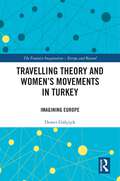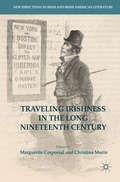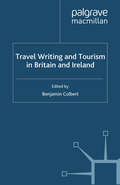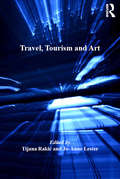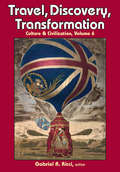- Table View
- List View
The Treason of the Intellectuals
by Julien Benda Roger KimballJulien Benda's classic study of 1920s Europe resonates today. The "treason of the intellectuals" is a phrase that evokes much but is inherently ambiguous. The book bearing this title is well known but little understood. This edition is introduced by Roger Kimball. From the time of the pre-Socratics, intellectuals were a breed apart. They were non-materialistic knowledge-seekers who believed in a universal humanism and represented a cornerstone of civilized society. According to Benda, this all began to change in the early twentieth century. In Europe in the 1920s, intellectuals began abandoning their attachment to traditional philosophical and scholarly ideals, and instead glorified particularisms and moral relativism. The "treason" of which Benda writes is the betrayal by the intellectuals of their unique vocation. He criticizes European intellectuals for allowing political commitment to insinuate itself into their understanding of the intellectual vocation, ushering the world into "the age of the intellectual organization of political hatreds." From the savage flowering of ethnic and religious hatreds in the Middle East and throughout Europe today to the mendacious demand for political correctness and multiculturalism on college campuses everywhere in the West, the treason of the intellectuals continues to play out its unedifying drama.
The Treason of the Intellectuals
by Julien Benda Roger KimballJulien Benda's classic study of 1920s Europe resonates today. The "treason of the intellectuals" is a phrase that evokes much but is inherently ambiguous. The book bearing this title is well known but little understood. This edition is introduced by Roger Kimball. From the time of the pre-Socratics, intellectuals were a breed apart. They were non-materialistic knowledge-seekers who believed in a universal humanism and represented a cornerstone of civilized society. According to Benda, this all began to change in the early twentieth century. In Europe in the 1920s, intellectuals began abandoning their attachment to traditional philosophical and scholarly ideals, and instead glorified particularisms and moral relativism. The "treason" of which Benda writes is the betrayal by the intellectuals of their unique vocation. He criticizes European intellectuals for allowing political commitment to insinuate itself into their understanding of the intellectual vocation, ushering the world into "the age of the intellectual organization of political hatreds." From the savage flowering of ethnic and religious hatreds in the Middle East and throughout Europe today to the mendacious demand for political correctness and multiculturalism on college campuses everywhere in the West, the treason of the intellectuals continues to play out its unedifying drama.
Treadmill of Production: Injustice and Unsustainability in the Global Economy
by Kenneth A. Gould David N. Pellow Allan SchnaibergSchnaiberg's concept of the treadmill of production is arguably the most visible and enduring theory to emerge in three decades of environmental sociology. Elaborated and tested, it has been found to be an accurate predictor of political-economic changes in the global economy. In the global South, it has figures prominently in the work of structural environmental analysts and has been used by many political-economic movements. Building new extensions and applications of the treadmill theory, this new book shows how and why northern analysts and governments have failed to protect our environment and secure our future. Using an empirically based political-economic perspective, the authors outline the causes of environmental degradation, the limits of environmental protection policies, and the failures of institutional decision-makers to protect human well-being.
Treadmill of Production: Injustice and Unsustainability in the Global Economy
by Kenneth A. Gould David N. Pellow Allan SchnaibergSchnaiberg's concept of the treadmill of production is arguably the most visible and enduring theory to emerge in three decades of environmental sociology. Elaborated and tested, it has been found to be an accurate predictor of political-economic changes in the global economy. In the global South, it has figures prominently in the work of structural environmental analysts and has been used by many political-economic movements. Building new extensions and applications of the treadmill theory, this new book shows how and why northern analysts and governments have failed to protect our environment and secure our future. Using an empirically based political-economic perspective, the authors outline the causes of environmental degradation, the limits of environmental protection policies, and the failures of institutional decision-makers to protect human well-being.
Travels with the Self: Interpreting Psychology as Cultural History (Psychoanalysis in a New Key Book Series)
by Philip CushmanTravels with the Self uses a hermeneutic perspective to critique psychology and demonstrate why the concept of the self and the modality of cultural history are so vitally important to the profession of psychology. Each chapter focuses on a theory, concept, sociopolitical or professional issue, philosophical problem, or professional activity that has rarely been critiqued from a historical, sociopolitical vantage point. Philip Cushman explores psychology’s involvement in consumerism, racism, shallow understandings of being human, military torture, political resistance, and digital living. In each case, theories and practices are treated as historical artifacts, rather than expressions of a putatively progressive, modern-era science that is uncovering the one, universal truth about human being. In this way, psychological theories and practices, especially pertaining to the concept of the self, are shown to be reflections of the larger moral understandings and political arrangements of their time and place, with implications for how we understand the self in theory and clinical practice. Drawing on the philosophies of critical theory and hermeneutics, Cushman insists on understanding the self, one of the most studied and cherished of psychological concepts, and its ills, practitioners, and healing technologies, as historical/cultural artifacts — surprising, almost sacrilegious, concepts. To this end, each chapter begins with a historical introduction that locates it in the historical time and moral/political space of the nation’s, the profession’s, and the author’s personal context. Travels with the Self brings together highly unusual and controversial writings on contemporary psychology that will appeal to psychoanalysts and psychotherapists, psychologists of all stripes, as well as scholars of philosophy, history, and cultural studies.
Travels with the Self: Interpreting Psychology as Cultural History (Psychoanalysis in a New Key Book Series)
by Philip CushmanTravels with the Self uses a hermeneutic perspective to critique psychology and demonstrate why the concept of the self and the modality of cultural history are so vitally important to the profession of psychology. Each chapter focuses on a theory, concept, sociopolitical or professional issue, philosophical problem, or professional activity that has rarely been critiqued from a historical, sociopolitical vantage point. Philip Cushman explores psychology’s involvement in consumerism, racism, shallow understandings of being human, military torture, political resistance, and digital living. In each case, theories and practices are treated as historical artifacts, rather than expressions of a putatively progressive, modern-era science that is uncovering the one, universal truth about human being. In this way, psychological theories and practices, especially pertaining to the concept of the self, are shown to be reflections of the larger moral understandings and political arrangements of their time and place, with implications for how we understand the self in theory and clinical practice. Drawing on the philosophies of critical theory and hermeneutics, Cushman insists on understanding the self, one of the most studied and cherished of psychological concepts, and its ills, practitioners, and healing technologies, as historical/cultural artifacts — surprising, almost sacrilegious, concepts. To this end, each chapter begins with a historical introduction that locates it in the historical time and moral/political space of the nation’s, the profession’s, and the author’s personal context. Travels with the Self brings together highly unusual and controversial writings on contemporary psychology that will appeal to psychoanalysts and psychotherapists, psychologists of all stripes, as well as scholars of philosophy, history, and cultural studies.
Travels in the Netherworld: Buddhist Popular Narratives of Death and the Afterlife in Tibet
by Bryan J. CuevasIn Travels in the Netherworld, Bryan J. Cuevas examines a fascinating but little-known genre of Tibetan narrative literature about the délok, ordinary men and women who claim to have died, traveled through hell, and then returned from the afterlife. These narratives enjoy audiences ranging from the most sophisticated monastic scholars to pious townsfolk, villagers, and nomads. Their accounts emphasize the universal Buddhist principles of impermanence and worldly suffering, the fluctuations of karma, and the feasibility of obtaining a favorable rebirth through virtue and merit. Providing a clear, detailed analysis of four vivid return-from-death tales, including the stories of a Tibetan housewife, a lama, a young noble woman, and a Buddhist monk, Cuevas argues that these narratives express ideas about death and the afterlife that held wide currency among all classes of faithful Buddhists in Tibet. Relying on a diversity of traditional Tibetan sources, Buddhist canonical scriptures, scholastic textbooks, ritual and meditation manuals, and medical treatises, in addition to the délok works themselves, Cuevas surveys a broad range of popular Tibetan Buddhist ideas about death and dying. He explores beliefs about the vulnerability of the soul and its journey beyond death, karmic retribution and the terrors of hell, the nature of demons and demonic possession, ghosts, and reanimated corpses. Cuevas argues that these extraordinary accounts exhibit flexibility between social and religious categories that are conventionally polarized and concludes that, contrary to the accepted wisdom, such rigid divisions as elite and folk, monastic and lay religion are not sufficiently representative of traditional Tibetan Buddhism on the ground. This study offers innovative perspectives on popular religion in Tibet and fills a gap in an important field of Tibetan literature.
The Travels and Adventures of Serendipity: A Study in Sociological Semantics and the Sociology of Science
by Robert K. Merton Elinor Barber James L. ShulmanFrom the names of cruise lines and bookstores to an Australian ranch and a nudist camp outside of Atlanta, the word serendipity--that happy blend of wisdom and luck by which something is discovered not quite by accident--is today ubiquitous. This book traces the word's eventful history from its 1754 coinage into the twentieth century--chronicling along the way much of what we now call the natural and social sciences. The book charts where the term went, with whom it resided, and how it fared. We cross oceans and academic specialties and meet those people, both famous and now obscure, who have used and abused serendipity. We encounter a linguistic sage, walk down the illustrious halls of the Harvard Medical School, attend the (serendipitous) birth of penicillin, and meet someone who "manages serendipity" for the U.S. Navy. The story of serendipity is fascinating; that of The Travels and Adventures of Serendipity, equally so. Written in the 1950s by already-eminent sociologist Robert Merton and Elinor Barber, the book--though occasionally and most tantalizingly cited--was intentionally never published. This is all the more curious because it so remarkably anticipated subsequent battles over research and funding--many of which centered on the role of serendipity in science. Finally, shortly after his ninety-first birthday, following Barber's death and preceding his own by but a little, Merton agreed to expand and publish this major work. Beautifully written, the book is permeated by the prodigious intellectual curiosity and generosity that characterized Merton's influential On the Shoulders of Giants. Absolutely entertaining as the history of a word, the book is also tremendously important to all who value the miracle of intellectual discovery. It represents Merton's lifelong protest against that rhetoric of science that defines discovery as anything other than a messy blend of inspiration, perspiration, error, and happy chance--anything other than serendipity.
The Travels and Adventures of Serendipity: A Study in Sociological Semantics and the Sociology of Science
by Robert K. Merton Elinor Barber James L. ShulmanFrom the names of cruise lines and bookstores to an Australian ranch and a nudist camp outside of Atlanta, the word serendipity--that happy blend of wisdom and luck by which something is discovered not quite by accident--is today ubiquitous. This book traces the word's eventful history from its 1754 coinage into the twentieth century--chronicling along the way much of what we now call the natural and social sciences. The book charts where the term went, with whom it resided, and how it fared. We cross oceans and academic specialties and meet those people, both famous and now obscure, who have used and abused serendipity. We encounter a linguistic sage, walk down the illustrious halls of the Harvard Medical School, attend the (serendipitous) birth of penicillin, and meet someone who "manages serendipity" for the U.S. Navy. The story of serendipity is fascinating; that of The Travels and Adventures of Serendipity, equally so. Written in the 1950s by already-eminent sociologist Robert Merton and Elinor Barber, the book--though occasionally and most tantalizingly cited--was intentionally never published. This is all the more curious because it so remarkably anticipated subsequent battles over research and funding--many of which centered on the role of serendipity in science. Finally, shortly after his ninety-first birthday, following Barber's death and preceding his own by but a little, Merton agreed to expand and publish this major work. Beautifully written, the book is permeated by the prodigious intellectual curiosity and generosity that characterized Merton's influential On the Shoulders of Giants. Absolutely entertaining as the history of a word, the book is also tremendously important to all who value the miracle of intellectual discovery. It represents Merton's lifelong protest against that rhetoric of science that defines discovery as anything other than a messy blend of inspiration, perspiration, error, and happy chance--anything other than serendipity.
Travelling with the Argonauts: Informal Networks Seen without a Vertical Lens
by Małgorzata IrekDrawing on rich ethnographic materials from longitudinal fieldwork on informal trading routes across Europe, Travelling with the Argonauts offers a new perspective in the research of the social space, reflecting on how best to investigate amorphous social phenomena, such as informal networks. Breaking with much current theory, the approach detailed here – the ‘Restricted Verticality Perspective’ – examines the horizontal dimension of social relations, and understands informality not as marginal or substandard, but as life itself, as the real experience of ordinary people.
Travelling towards Home: Mobilities and Homemaking (Articulating Journeys: Festivals, Memorials, and Homecomings #3)
by Nicola Frost Tom SelwynAs we grapple with a growing refugee crisis, a hardening of anti-immigration sentiment, and deepening communal segregation in many parts of the developed world, questions of the nature of home and homemaking are increasingly critical. This collection brings ethnographic insight into the practices of homemaking, exploring a diverse range of contexts ranging from economic migrants to new Chinese industrial cities, Jewish returnees from Israel to Ukraine, and young gay South Asians in London. While negotiating widely varying social-political contexts, these studies suggest an unavoidably multiple understanding of home, while provoking new understandings of the material and symbolic process of making oneself “at home.”
Travelling towards Home: Mobilities and Homemaking (Articulating Journeys: Festivals, Memorials, and Homecomings #3)
by Nicola Frost and Tom SelwynAs we grapple with a growing refugee crisis, a hardening of anti-immigration sentiment, and deepening communal segregation in many parts of the developed world, questions of the nature of home and homemaking are increasingly critical. This collection brings ethnographic insight into the practices of homemaking, exploring a diverse range of contexts ranging from economic migrants to new Chinese industrial cities, Jewish returnees from Israel to Ukraine, and young gay South Asians in London. While negotiating widely varying social-political contexts, these studies suggest an unavoidably multiple understanding of home, while provoking new understandings of the material and symbolic process of making oneself “at home.”
Travelling Theory and Women’s Movements in Turkey: Imagining Europe (The Feminist Imagination - Europe and Beyond)
by Demet GulcicekDrawing on archival research, Travelling Theory and Women’s Movements in Turkey examines the imagination of Europe in the context of women’s rights movements in a self-defined non-European setting. It brings travelling theory, poststructuralist feminist theories and orientalist studies together to provide an original theoretical framework for understanding the complex and often contradictory imaginations of Europe. Such imaginations can be an object of desire, fantasy, hate and hostility in a non-European context. This volume sheds light on the manner in which local power dynamics are reproduced, negotiated and subverted during the travel of women’s and feminist movements. With a focus on the late Ottoman Empire, the book questions how ‘Other’ positions can be inhabited by the ‘Self’ and unpacks sexual and normative dimensions of demanding women’s rights in this context. As such, it will appeal to scholars of sociology, cultural studies and gender studies with interests in feminist theory and notions of European and non-European categories.
Travelling Theory and Women’s Movements in Turkey: Imagining Europe (The Feminist Imagination - Europe and Beyond)
by Demet GulcicekDrawing on archival research, Travelling Theory and Women’s Movements in Turkey examines the imagination of Europe in the context of women’s rights movements in a self-defined non-European setting. It brings travelling theory, poststructuralist feminist theories and orientalist studies together to provide an original theoretical framework for understanding the complex and often contradictory imaginations of Europe. Such imaginations can be an object of desire, fantasy, hate and hostility in a non-European context. This volume sheds light on the manner in which local power dynamics are reproduced, negotiated and subverted during the travel of women’s and feminist movements. With a focus on the late Ottoman Empire, the book questions how ‘Other’ positions can be inhabited by the ‘Self’ and unpacks sexual and normative dimensions of demanding women’s rights in this context. As such, it will appeal to scholars of sociology, cultural studies and gender studies with interests in feminist theory and notions of European and non-European categories.
A Traveller in Thirteenth-Century Arabia / Ibn al-Mujawir's Tarikh al-Mustabsir (Hakluyt Society, Third Series)
by G. Rex SmithThis is the first English translation of the Tarikh al-Mustabsir, written in the early quarter of the thirteenth century by Ibn al-Mujawir. The text is a fascinating account of the western and southern areas of the Arabian Peninsula by a man from the east of the Islamic world, probably from Khurasan in Iran. Ibn al-Mujawir was a man who in all probability followed the age-old Islamic practice of making the pilgrimage to Mecca and thereafter travelling in the area to further his business interests. His route began in Mecca and essentially ran south through the Red Sea coastal plain, Tihamah, down into the Yemen and along the southern coast of the peninsula. He paused long in Aden, where he observed closely the activities of the port to report at some length on its administration, its taxes, its markets, its currency, its weights and measures, and the like. His route then continued along the southern coast of Arabia into the Gulf, and he presumably returned home to the east via Iraq. The author is a wonderful observer of people: their buildings, their dress, their customs, their agriculture, their food and their history. This book is a unique source for the social and economic history of thirteenth-century south Arabia, written with a humour and wit otherwise unknown in the writings of medieval Islam. The text is of major linguistic importance too, written as it is in a far from classical Arabic. This translation is fully annotated with an introduction, appendices, glossary and full index, and contains maps and illustrations.
A Traveller in Thirteenth-Century Arabia / Ibn al-Mujawir's Tarikh al-Mustabsir: Ibn Al-mujawir's Tarikh Al-mustabsir (Hakluyt Society, Third Series #No. 19)
by G. Rex SmithThis is the first English translation of the Tarikh al-Mustabsir, written in the early quarter of the thirteenth century by Ibn al-Mujawir. The text is a fascinating account of the western and southern areas of the Arabian Peninsula by a man from the east of the Islamic world, probably from Khurasan in Iran. Ibn al-Mujawir was a man who in all probability followed the age-old Islamic practice of making the pilgrimage to Mecca and thereafter travelling in the area to further his business interests. His route began in Mecca and essentially ran south through the Red Sea coastal plain, Tihamah, down into the Yemen and along the southern coast of the peninsula. He paused long in Aden, where he observed closely the activities of the port to report at some length on its administration, its taxes, its markets, its currency, its weights and measures, and the like. His route then continued along the southern coast of Arabia into the Gulf, and he presumably returned home to the east via Iraq. The author is a wonderful observer of people: their buildings, their dress, their customs, their agriculture, their food and their history. This book is a unique source for the social and economic history of thirteenth-century south Arabia, written with a humour and wit otherwise unknown in the writings of medieval Islam. The text is of major linguistic importance too, written as it is in a far from classical Arabic. This translation is fully annotated with an introduction, appendices, glossary and full index, and contains maps and illustrations.
Traveling Irishness in the Long Nineteenth Century
by Marguérite Corporaal Christina MorinExploring the effects of traveling, migration, and other forms of cultural contact, particularly within Europe, this edited collection explores the act of traveling and the representation of traveling by Irish men and women from diverse walks of life in the period between Grattan’s Parliament (1782) and World War I (1914). This was a period marked by an increasing physical and cultural mobility of Irish throughout Britain, Continental Europe, the Americas, and the Pacific. Travel was undertaken for a variety of reasons: during the Romantic period, the ‘Grand Tour’ and what is now sometimes referred to as medical tourism brought Irish artists and intellectuals to Europe, where cultural exchanges with other writers, artists, and thinkers inspired them to introduce novel ideas and cultural forms to their Irish audiences. Showing this impact of the nineteenth-century Irish across national borders and their engagement with global cultural and linguistic traditions, the volume will provide novel insights into the transcultural spheres of the arts, literature, politics, and translation in which they were active.
Traveling Irishness in the Long Nineteenth Century
by Marguérite Corporaal Christina MorinExploring the effects of traveling, migration, and other forms of cultural contact, particularly within Europe, this edited collection explores the act of traveling and the representation of traveling by Irish men and women from diverse walks of life in the period between Grattan’s Parliament (1782) and World War I (1914). This was a period marked by an increasing physical and cultural mobility of Irish throughout Britain, Continental Europe, the Americas, and the Pacific. Travel was undertaken for a variety of reasons: during the Romantic period, the ‘Grand Tour’ and what is now sometimes referred to as medical tourism brought Irish artists and intellectuals to Europe, where cultural exchanges with other writers, artists, and thinkers inspired them to introduce novel ideas and cultural forms to their Irish audiences. Showing this impact of the nineteenth-century Irish across national borders and their engagement with global cultural and linguistic traditions, the volume will provide novel insights into the transcultural spheres of the arts, literature, politics, and translation in which they were active.
Travel Writing and Tourism in Britain and Ireland
by Benjamin ColbertFrom the mid-eighteenth century to the twentieth, tourism became established as a leisure industry and travel writing as a popular genre. In this collection of essays, leading international historians and travel writing experts examine the role of home tourism in the UK and Ireland in the development of national identities and commercial culture.
Travel, Tourism, and Identity
by Gabriel R. RicciTravel, Tourism and Identity addresses the psychological and social adjustments that occur when people make contact with others outside their social, cultural, or linguistic groups. Whether such contact is the result of tourism, seeking exile, or relocating abroad, the volume's contributors demonstrate how one's identity, cultural assumptions, and worldview can be brought into question.In some cases, the traveller finds that bridging the social and cultural gap between himself and the new society is fairly easy. In other cases, the traveller discovers that reorienting himself requires absorbing a new cultural history and traditions. The contributors argue that making these adjustments will surely enhance the traveller's or tourist's experience; otherwise the traveller or tourist will be at risk of becoming a marginalized figure, one disconnected from the society that surrounds him.This latest volume in the Culture & Civilization series features a collection of essays on travel and tourism. The essays cover a range of topics from historical travels to modern social identities. They discuss ancient travels, contemporary travels in Europe, Africa and sustainable eco-tourism, and the politics of tourism. Essays also address experiences of Grenada's "Spice Island" identity, and the effects of globalization and migrations on personal identity.
Travel, Tourism, and Identity (Culture And Civilization Ser.)
by Gabriel R. RicciTravel, Tourism and Identity addresses the psychological and social adjustments that occur when people make contact with others outside their social, cultural, or linguistic groups. Whether such contact is the result of tourism, seeking exile, or relocating abroad, the volume's contributors demonstrate how one's identity, cultural assumptions, and worldview can be brought into question.In some cases, the traveller finds that bridging the social and cultural gap between himself and the new society is fairly easy. In other cases, the traveller discovers that reorienting himself requires absorbing a new cultural history and traditions. The contributors argue that making these adjustments will surely enhance the traveller's or tourist's experience; otherwise the traveller or tourist will be at risk of becoming a marginalized figure, one disconnected from the society that surrounds him.This latest volume in the Culture & Civilization series features a collection of essays on travel and tourism. The essays cover a range of topics from historical travels to modern social identities. They discuss ancient travels, contemporary travels in Europe, Africa and sustainable eco-tourism, and the politics of tourism. Essays also address experiences of Grenada's "Spice Island" identity, and the effects of globalization and migrations on personal identity.
Travel, Tourism and Art (Current Developments in the Geographies of Leisure and Tourism)
by Tijana Raki 263 Jo-Anne LesterArt, in its many forms, has long played an important role in people’s imagination, experience and remembrance of places, cultures and travels as well as in their motivation to travel. Travel and tourism, on the other hand, have also inspired numerous artists and featured in many artworks. The fascinating relationships between travel, tourism and art encompass a wide range of phenomena from historical ’Grand Tours’ during which a number of travellers experienced or produced artwork, to present-day travel inspired by art, artworks produced by contemporary travellers or artworks produced by locals for tourist consumption. Focusing on the representations of ’touristic’ places, locals, travellers and tourists in artworks; the role of travel and tourism in inspiring artists; as well as the role of art and artwork in imagining, experiencing and remembering places and motivating travel and tourism; this edited volume provides a space for an exploration of both historical and contemporary relationships between travel, tourism and art. Bringing together scholars from a wide range of disciplines and fields of study including geography, anthropology, history, philosophy, and urban, cultural, tourism, art and leisure studies, this volume discusses a range of case studies across different art forms and locales.
Travel, Tourism and Art (Current Developments in the Geographies of Leisure and Tourism)
by Jo-Anne LesterArt, in its many forms, has long played an important role in people’s imagination, experience and remembrance of places, cultures and travels as well as in their motivation to travel. Travel and tourism, on the other hand, have also inspired numerous artists and featured in many artworks. The fascinating relationships between travel, tourism and art encompass a wide range of phenomena from historical ’Grand Tours’ during which a number of travellers experienced or produced artwork, to present-day travel inspired by art, artworks produced by contemporary travellers or artworks produced by locals for tourist consumption. Focusing on the representations of ’touristic’ places, locals, travellers and tourists in artworks; the role of travel and tourism in inspiring artists; as well as the role of art and artwork in imagining, experiencing and remembering places and motivating travel and tourism; this edited volume provides a space for an exploration of both historical and contemporary relationships between travel, tourism and art. Bringing together scholars from a wide range of disciplines and fields of study including geography, anthropology, history, philosophy, and urban, cultural, tourism, art and leisure studies, this volume discusses a range of case studies across different art forms and locales.
Travel, Discovery, Transformation
by Gabriel R. RicciThis latest volume in the Culture & Civilization series gathers interdisciplinary voices to present a collection of essays on travel and travel narratives. The essays span a range of topics from iconic ancient travel stories to modern tourism. They discuss travel in the ancient world, modern heroic travels, the literary culture of missionary travel, the intersection of fiction and travel narratives, modern literary traditions and visions of Greece, personal identity, and expatriation. Essays also address travel memoirs, the re-imagining of worlds through travel, transformed landscapes and animals in travel narratives, diplomacy, English women travel writers, and pilgrimage and health in the medieval world.The history of travel writing takes in multiple pursuits: exploration and conquest, religious pilgrimage and missionary work, educational tourism and diplomacy, scientific and personal discovery, and natural history and oral history. As a literary genre, it has enhanced a wide range of disciplines, including geography, ethnography, anthropology, and linguistics. Moreover, twenty-first-century interests in travel and travel writing have produced a global framework that promises to expand travel's theoretical reach into the depths of the Internet, thus challenging our conventional concept of what it means to travel.The fact that travel and travel writing have a prehistory that is embedded in foundational religious texts and ancient narratives of journey, like the Odyssey and the Epic of Gilgamesh, makes both travel and travel writing fundamental and essential expressions of humanity. Travel encourages writing, particularly as epistolary and poetic chronicling. This is clearly a history and tradition that began with human communication and which has kept pace with our collective development.







